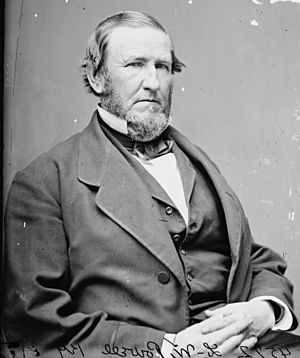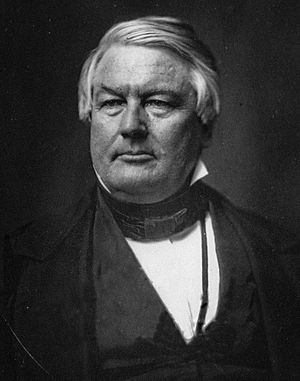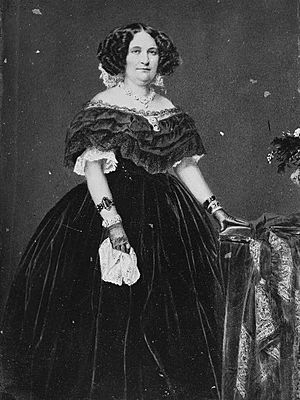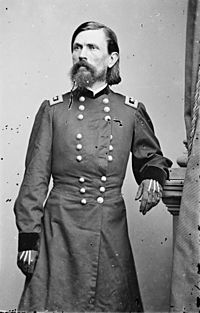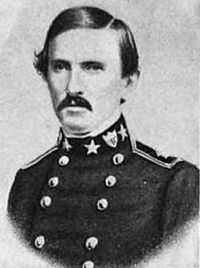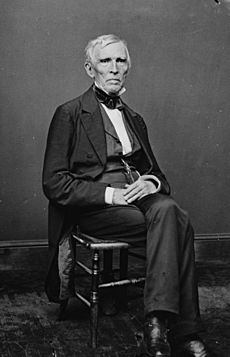John J. Crittenden facts for kids
Quick facts for kids
John J. Crittenden
|
|
|---|---|
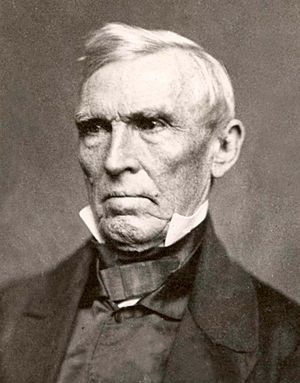 |
|
| Member of the U.S. House of Representatives from Kentucky's 8th district |
|
| In office March 4, 1861 – March 3, 1863 |
|
| Preceded by | William Simms |
| Succeeded by | William Randall |
| United States Senator from Kentucky |
|
| In office March 4, 1855 – March 3, 1861 |
|
| Preceded by | Archibald Dixon |
| Succeeded by | John Breckinridge |
| In office March 31, 1842 – June 12, 1848 |
|
| Preceded by | Henry Clay |
| Succeeded by | Thomas Metcalfe |
| In office March 4, 1835 – March 3, 1841 |
|
| Preceded by | George Bibb |
| Succeeded by | James Morehead |
| In office March 4, 1817 – March 3, 1819 |
|
| Preceded by | Martin Hardin |
| Succeeded by | Richard Johnson |
| 15th and 22nd United States Attorney General |
|
| In office July 22, 1850 – March 4, 1853 |
|
| President | Millard Fillmore |
| Preceded by | Reverdy Johnson |
| Succeeded by | Caleb Cushing |
| In office March 5, 1841 – September 12, 1841 |
|
| President | William Henry Harrison John Tyler |
| Preceded by | Henry Gilpin |
| Succeeded by | Hugh Legaré |
| 17th Governor of Kentucky | |
| In office September 6, 1848 – July 31, 1850 |
|
| Lieutenant | John Helm |
| Preceded by | William Owsley |
| Succeeded by | John Helm |
| 22nd Secretary of State of Kentucky | |
| In office April 1834 – February 4, 1835 |
|
| Governor | James Morehead |
| Preceded by | Lewis Sanders |
| Succeeded by | William Owsley |
| Personal details | |
| Born |
John Jordan Crittenden
September 10, 1787 Versailles, Virginia (now part of Kentucky), U.S. |
| Died | July 26, 1863 (aged 75) Frankfort, Kentucky, U.S. |
| Resting place | Frankfort Cemetery |
| Political party | Democratic-Republican (before 1825) National Republican (1825–1830) Whig (1830–1856) American (1856–1859) Constitutional Union (1859–1861) Unionist (1861–1863) |
| Spouses | Sarah Lee Maria Knox Todd Elizabeth Moss |
| Education | Washington and Lee University College of William and Mary (BA) |
| Signature | |
| Military service | |
| Allegiance | |
| Branch/service | Kentucky Militia |
| Battles/wars | War of 1812 |
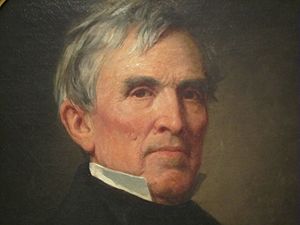
John Jordan Crittenden (September 10, 1787 – July 26, 1863) was an important American politician from Kentucky. He served in the U.S. House of Representatives and the U.S. Senate. He was also the United States Attorney General twice and the 17th Governor of Kentucky.
Crittenden was a strong supporter of the Whig Party and its leader, Henry Clay. He often tried to find ways for different political groups to agree. As the country moved closer to the Civil War, he worked hard to prevent it. He proposed a plan called the Crittenden Compromise to keep the states united.
During the Civil War, Crittenden supported the Union. Interestingly, his sons fought on opposite sides. One son became a general for the Confederate Army, while another became a general for the Union Army. Crittenden continued to work for peace and unity until his death.
Contents
Early Life and Family History
John Jordan Crittenden was born on September 10, 1787. His birthplace was near Versailles, Kentucky. He was the second child of Major John Crittenden, Sr., a veteran of the American Revolutionary War. His mother was Judith Harris.
John and Judith Crittenden had nine children in total. John's family had Welsh roots, and his mother's family were French Huguenots. His father had helped survey land in Kentucky after the American Revolution. Two of John's brothers became lawyers, and one was a farmer.
Education and Legal Training
Crittenden started his education at Pisgah Academy. He then went to a boarding school in Jessamine County. There, he became close friends with Francis Preston Blair.
After boarding school, Crittenden studied law with Judge George M. Bibb in Lexington, Kentucky. He later attended Washington College (now Washington and Lee University) in Virginia. He also studied law at the College of William and Mary.
Marriages and Children
On May 27, 1811, Crittenden married Sarah O. Lee. She was a cousin of future U.S. President Zachary Taylor. They had seven children together before Sarah passed away in 1824.
Two of their sons became generals. George B. Crittenden fought for the Confederacy. Thomas Leonidas Crittenden fought for the Union. Their daughter, Ann Mary Butler Crittenden Coleman, later wrote a book about her father's life.
On November 15, 1826, Crittenden married Maria Knox Todd. She was a widow with three children, whom Crittenden raised as his own. They also had two more children together. Maria died in 1851.
On February 27, 1853, Crittenden married his third wife, Elizabeth Moss. She was also a widow. She remained his wife until his death.
Early Political Career in Kentucky
Crittenden became a lawyer in 1807. He first practiced law in Woodford County. Later, he moved to Russellville in Logan County, Kentucky. He also served as the attorney general of the Illinois Territory for a short time.
When he returned to Kentucky, Crittenden continued his law practice. He also owned enslaved people. In 1830, his household included 6 enslaved people. By 1850, he owned 44 enslaved people. In 1860, he owned ten enslaved people.
Serving in the State Legislature
Crittenden's career as an elected official began in the Kentucky House of Representatives. He represented Logan County from 1811 to 1817. He was chosen as the Speaker several times.
During the War of 1812, he served as an aide to General Samuel Hopkins. He also served Governor Isaac Shelby at the Battle of the Thames.
First Term in the U.S. Senate
In 1817, the Kentucky General Assembly elected Crittenden to the U.S. Senate. He was the youngest member there. He became the second chairman of the new Committee on the Judiciary.
Crittenden found state politics more interesting. Also, he had more family responsibilities. Because of this, he decided to resign from his Senate seat on March 3, 1819.
Working as a Lawyer in Frankfort
After leaving Congress, Crittenden moved to Frankfort, Kentucky, the state capital. This helped him get more legal clients. He represented important people like former presidents James Madison and James Monroe.
He also worked with Henry Clay on a famous murder trial. Crittenden argued that the killing was self-defense. The jury found the person not guilty very quickly.
Joining the Whig Party
Crittenden became a key figure in the National Republican Party. This party later became the Whig Party. He was a strong supporter of Henry Clay.
In 1828, President John Quincy Adams nominated Crittenden to the U.S. Supreme Court. However, senators who supported Andrew Jackson blocked his confirmation.
Serving as Kentucky Secretary of State
In 1834, Kentucky Governor James T. Morehead appointed Crittenden as Secretary of State. Later that year, the General Assembly elected him back to the U.S. Senate.
Second Term in the U.S. Senate
In the Senate, Crittenden was named to important committees. He often spoke out against President Jackson and his policies. He supported Henry Clay's ideas for using money from public land sales.
Crittenden was seen as a moderate on the issue of slavery. He wanted to keep slavery out of politics. He opposed extreme measures from both sides.
Working with Presidents Harrison and Tyler
In the 1840 election, Crittenden supported William Henry Harrison for president. When Harrison won, he appointed Crittenden as Attorney General. Crittenden resigned his Senate seat for this role.
Harrison died shortly after becoming president. John Tyler became president. Tyler disagreed with the Whig Party's plans. Crittenden and other Whigs in Tyler's cabinet resigned in protest in 1841.
Crittenden returned to Kentucky with no political office. His friends bought his childhood home and gave it to him as a gift.
Third Term in the U.S. Senate
Crittenden was appointed to the U.S. Senate again in 1842. He filled the seat left by Henry Clay. He was later elected to a full term. He continued to support moderate policies.
He did not support the Mexican–American War in 1846. He believed the U.S. should try to make peace. His sons, George and Thomas, both served in this war.
Governor of Kentucky
In 1848, Crittenden ran for Governor of Kentucky. He hoped his election would help Zachary Taylor win Kentucky's votes in the presidential election. He won the governorship, defeating Lazarus W. Powell.
After Taylor was elected president, he offered Crittenden the job of Secretary of State. Crittenden refused the offer. He feared it would look like a "corrupt bargain" and wanted to help unite the Whig Party in Kentucky.
Key Actions as Governor
As governor, Crittenden strongly supported public education. He worked with Robert Jefferson Breckinridge, known as the "Father of public school system in Kentucky." A new law was passed to fund public schools.
He also ordered repairs for the state prison after a fire. He called for a detailed geological survey of the state. Crittenden also suggested creating a special fund to pay off the state's debt.
During his term, Kentucky adopted a new state constitution. Crittenden also strongly spoke out against states leaving the Union. He believed in keeping the country together.
Return to National Politics
When President Taylor died, Millard Fillmore became president. Fillmore offered Crittenden the job of Attorney General again. Crittenden accepted and resigned as governor in 1850.
As Attorney General, Crittenden gave important legal opinions. He supported the fugitive slave law, which was part of the Compromise of 1850. This helped keep the Compromise intact and reduce tensions.
In 1851, Harvard University gave Crittenden an honorary law degree. He also temporarily served as Secretary of State. In this role, he warned Britain and France not to interfere with Cuba's independence.
Fourth Term in the U.S. Senate
In 1853, Crittenden was elected to the U.S. Senate for his fourth time. He was 69 years old, making him the oldest member of the Senate.
By this time, the Whig Party was falling apart. Crittenden joined the Know Nothing Party. He did not agree with everything they believed, but he did not want to join the Democrats or the new Republican Party. The Republican Party was against slavery, which Crittenden wanted to keep out of politics.
Crittenden was concerned about the violence in Kansas Territory. He opposed the Kansas–Nebraska Act. He tried to find solutions to bring peace to the territory.
Efforts to Prevent Civil War
From 1858 to 1860, Crittenden worked to find a compromise. He wanted to prevent war over slavery and territory issues. He helped form the Constitutional Union Party in 1860.
He was asked to run for president, but he was 73 years old. Instead, he helped John Bell get the party's nomination.
The Crittenden Compromise
Even after Abraham Lincoln was elected president in 1860, Crittenden believed war could be avoided. He thought a compromise was possible. He proposed the Crittenden Compromise in December 1860.
This plan included six changes to the U.S. Constitution. It also had four congressional resolutions. The goal was to restore the Missouri Compromise line. This line would divide slave and free territories.
The compromise also aimed to protect slavery where it already existed. It would ensure slaveholders were paid for runaway slaves. Crittenden wanted these changes to be permanent.
However, President-elect Lincoln did not want to extend slavery into new territories. Republicans in Congress blocked Crittenden's plan. After this, more Southern states decided to leave the Union.
Kentucky's Neutrality
Crittenden returned to Kentucky in 1861. He tried to convince his home state to stay in the Union. He joined other leaders to discuss Kentucky's role in the war.
They decided on a policy of "armed neutrality." This meant Kentucky would not take sides. Crittenden helped organize the Home Guard, a pro-Union militia. He even joined as a private soldier.
Crittenden's family was divided by the war. His son, George B. Crittenden, became a general for the Confederacy. His other son, Thomas Leonidas Crittenden, became a general for the Union. Another son, Eugene, also served in the Union Army.
Final Years in Congress and Death
In 1861, Crittenden was elected to the United States House of Representatives. He supported the Union. He introduced the Crittenden–Johnson Resolution. This resolution stated that the war's goal was to preserve the Union, not to conquer Southern states.
He criticized some of President Lincoln's policies. He spoke against West Virginia joining the Union. He also opposed the Emancipation Proclamation and using enslaved people as soldiers.
Crittenden's health began to fail. He had planned to retire from Congress. However, his friends convinced him to run for re-election in 1863.
He became ill while traveling to seek treatment. He returned home to Frankfort, where he died on July 26, 1863. He was buried in the State Cemetery in Frankfort.
Legacy and Honors
- In Kentucky, Crittenden County and the town of Crittenden are named after him.
- A World War II Liberty Ship was named SS John J. Crittenden in his honor.
- Camp Floyd in Utah was renamed Fort Crittenden.
Images for kids
-
Daguerreotype of John J. Crittenden, c. 1846. By Mathew Brady.


